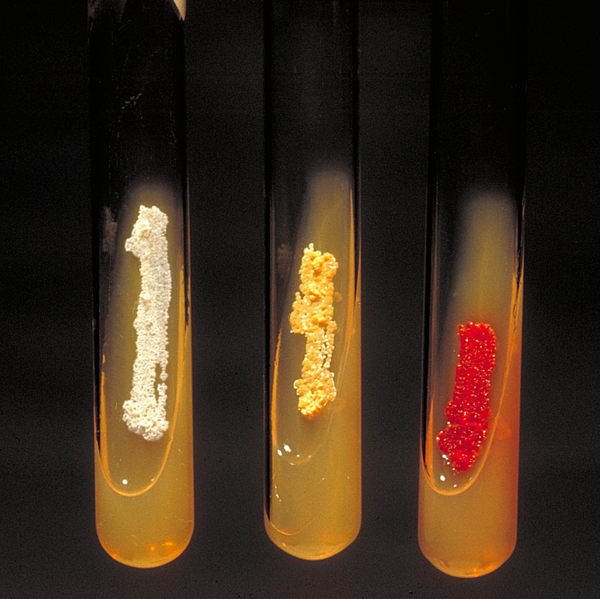Nocardia asteroides
Classification
Higher order taxa
Domain (Bacteria); Phylum (Actinobacteria); Class (Actinobacteridae); Order (Corynebacterineae); Family (Nocardiaceae); Genus (Nocardia)
Species
Nocardia asteroides
Description and significance
Species of Nocardia genus are Gram –positive. Nocardia asteroides are found worldwide and they are saprophytes, they live on dead decaying organic matter in the soil, water, dust and on vegetation .They are important in the soil because they break down dead and decaying organic matter into simple substances that can be taken up and recycled by plants. Nocardia asteroides appear as filaments and their colonies usually appear yellowish in a slant culture media as seen from the Images below [1, 4, and 7].
Genome structure
The complete genome structure of Nocardia asteroides is not available to the public. The total genome size of Nocardia asteroides is 7.5 Mb with a large linear plasmid of 220 kb. It is known though that Nocardia asteroides drug pattern VI strain is 99.5 % genomically identical to Nocardia cyriacigeorgica in HSP gene sequence [4]. There are only two differences in a 373-bp region; the amino acid sequences are identical in both of the above Nocardia species. Nocardia farcinica is the Nocardia species with a complete genome that is available to the general public. It has one circular chromosome and two circular plasmids .Its circular chromosome consists 6,021,225 bp and circular plasmids, pNf1 and pNF2 consists of 184, 027bp and 87,093 bp respectively [2, 4].
Cell and colony structure
Nocardia asteroides species are filamentous aerobic, Gram-positive and mycolic acid cell wall bacteria. Nocardia colonies vary from white, to tan, orange and red in color they have a lipid bilayer cell membrane with associated proteins [1, 7]. Their cell envelopes consist of a Peptidoglycan cell wall. All mycolic acids comprising the cell wall of Nocardia asteroides are saturated mycolic acids. As of today, researches have not indicated association of Pili nor flagella on Nocardia asteroides. Nocardia asteroides experience an optimal growth at body temperature.
Metabolism
Since Nocardia is a soil bacterium, it uses different compounds as its source for carbon and energy. The primary source energy for Nocardia asteroides is acetate and gluconate while its source of carbon and nitrogen is sucrose and acetamide.During nitrogen assimilation glutamate and glutamine is formed .Nocardia asteroides uses the GS/GOGAT pathway to form glutamine which contains the enzymes glutamine synthetase and glutamate synthetase which catalyzes glutamate from α-ketogluterate and ammonia [1, 7].
Ecology
Vibrio mimicus is a Gram-negative bacterium that is an indigenous member of diverse aquatic environments, including seawater, freshwater, and brackish water, where it has been found both as a free-living bacterium and in association with zooplankton, crustaceans, filter-feeding mollusks, turtle eggs, and fish. [2, 5, 6, 7, and 8].
Pathology and Ecology
Nocardia asteroides live on dead decaying organic matter in the soil, water, dust and on vegetation. Nocardiosis is a chronic bacterial disease of humans and many other animals originating in the respiratory tract and disseminated by way of blood to other organs. It is caused by either introduction of the species into the skin or by inhalation of the species from its habitat. Nocardia asteroides accounts for 86% of systematic nocardiosis in humans and 98% of cerebral nocardial abscesses and 2% of all cerebral abscesses [1, 3, and 6]. The majority of infections occur in patients with weakened cell-mediated immunity. Patients commonly also include those who have received bone-marrow transplantations and are on immunosuppressive therapy, those with HIV/AIDS, and those with malignancies [1, 7]. The disease usually begins with malaise, loss of weight, fever and night sweats. Nocardiosis is found worldwide in persons of all ages. Nocardia species are generally resistant to penicillin and require six months to one year of antibiotic treatment. Early treatment of nocardiosis with sulphonamide drugs before the disease has spread to the brain has reduced the mortality rate from nocardiosis. [1,7]
References
1. Wilson JW. Nocardiosis: Updates and Clinical Overview 87: 403-07. National Center for Biotechnology Information. Mayo Clinic April 2012 .Volume 87 pg. 403-07.
2. Conville, Witebsky, Patricia S, Frank G. "Organisms Designated as Nocardia Asteroides Drug Pattern Type VI Are Members of the Species Nocardia Cyriacigeorgica.", Journal of Clinical Microbiology. July 2007, Volume 45 No 7 pg. 2257-2259. http://jcm.asm.org/content/45/7/2257.
3. Nur Adura Yaakup, Kartini Rahmat, Norlisah Ramli, Sheau Fung Sia. "Cerebralnocardiosis in an Immunocompetent Patient: A Diagnostic Dilemma. “European Journal of Radiology Extra. Aug. 2009. Vol 71 issue 2, Pages e47–e51. http://www.sciencedirect.com/science/article/pii/S1571467509000182.
4. Orchard VA, Good fellow M. "Numerical Classification of Some Named Strains of Nocardia Asteroides and Related Isolates from Soil." National Center for Biotechnology Information. U.S. National Library of Medicine, Journal of general microbiology June 1980 volume 118(2) pg.295-312.
5.The volatiles of pathogenic and nonpathogenic mycobacteria and related bacteria, Nawrath T, Mgode GF, Weetjens B, Kaufmann SH, Schulz S.Beilstein J . 2012, 8:290-9
6. Nocardia infection in a renal transplant recipient, Kaswan KK, Vanikar AV, Feroz A, Patel HV, Gumber M, Trivedi HL. Saudi J. 2011 Nov, 22(6):1203-4
7. Michael A Saubolle, Den Sussland. "Nocardiosis, Review of Clinical and Laboratory Experience." Oct. 2003. Journal of clinical microbiology Volume No 10 pg. 4497-4501 http://jcm.asm.org/content/41/10/4497.
Edited by Franck Mujyanama, Student of Dr. Lisa R Moore, University of Southern Maine

